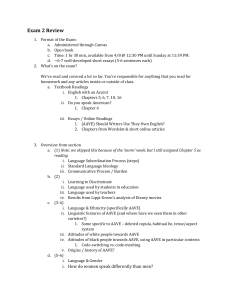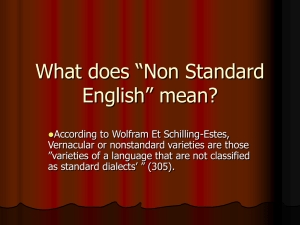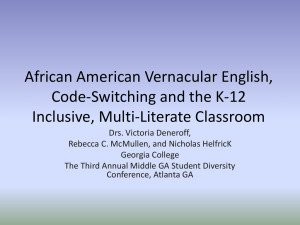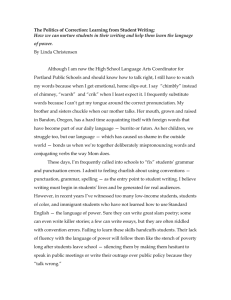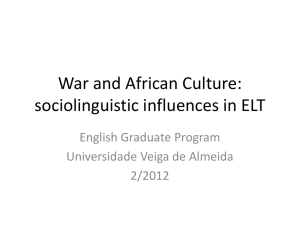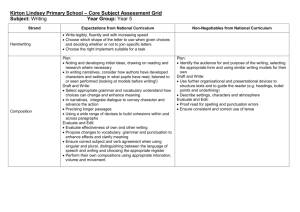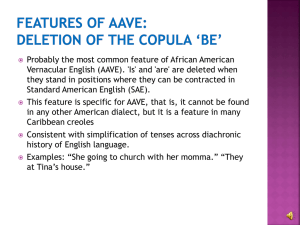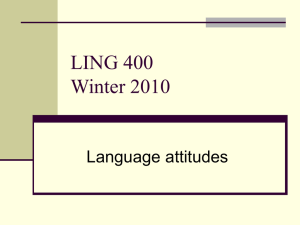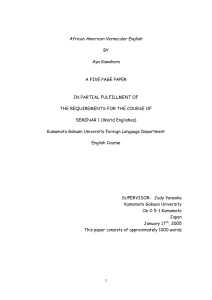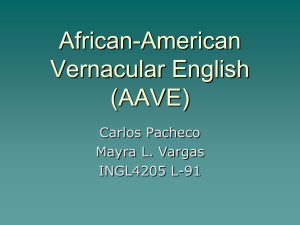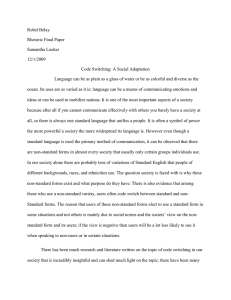File - Ashley`s Writing Notebook
advertisement
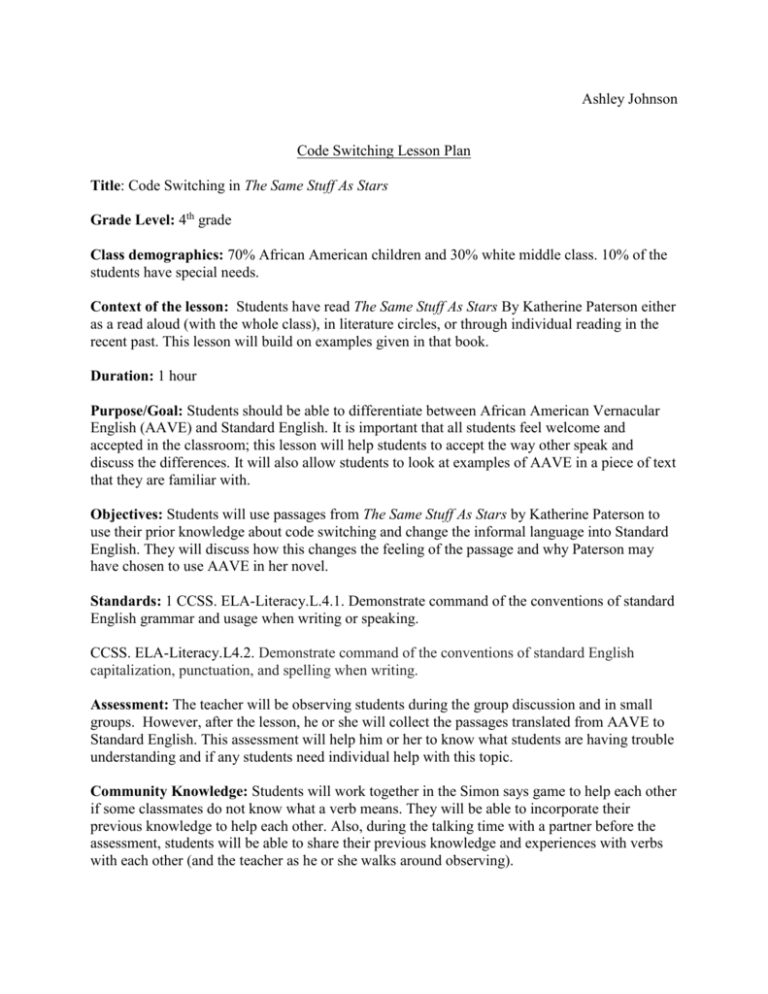
Ashley Johnson Code Switching Lesson Plan Title: Code Switching in The Same Stuff As Stars Grade Level: 4th grade Class demographics: 70% African American children and 30% white middle class. 10% of the students have special needs. Context of the lesson: Students have read The Same Stuff As Stars By Katherine Paterson either as a read aloud (with the whole class), in literature circles, or through individual reading in the recent past. This lesson will build on examples given in that book. Duration: 1 hour Purpose/Goal: Students should be able to differentiate between African American Vernacular English (AAVE) and Standard English. It is important that all students feel welcome and accepted in the classroom; this lesson will help students to accept the way other speak and discuss the differences. It will also allow students to look at examples of AAVE in a piece of text that they are familiar with. Objectives: Students will use passages from The Same Stuff As Stars by Katherine Paterson to use their prior knowledge about code switching and change the informal language into Standard English. They will discuss how this changes the feeling of the passage and why Paterson may have chosen to use AAVE in her novel. Standards: 1 CCSS. ELA-Literacy.L.4.1. Demonstrate command of the conventions of standard English grammar and usage when writing or speaking. CCSS. ELA-Literacy.L4.2. Demonstrate command of the conventions of standard English capitalization, punctuation, and spelling when writing. Assessment: The teacher will be observing students during the group discussion and in small groups. However, after the lesson, he or she will collect the passages translated from AAVE to Standard English. This assessment will help him or her to know what students are having trouble understanding and if any students need individual help with this topic. Community Knowledge: Students will work together in the Simon says game to help each other if some classmates do not know what a verb means. They will be able to incorporate their previous knowledge to help each other. Also, during the talking time with a partner before the assessment, students will be able to share their previous knowledge and experiences with verbs with each other (and the teacher as he or she walks around observing). Procedure: 1. 15 min – Introduce the topic: Ask students what they know about AAVE and Standard English. Ask if anyone has any personal experiences or stories they would like to share with the class regarding the topic. Engage students by asking when they would use informal and formal language. This should promote a short discussion and get students interested in the subject. This activity will help to make all students feel included. Some may have personal stories to share and others may not; however, everyone should be actively listening and feel comfortable to share their stories. This may help some students to better understand the way others speak. 2. 5 min – Incorporate The Same Stuff As Stars: Ask students if they remember any AAVE used in The Same Stuff As Stars. Ask students about the role it played in the story. By using a text that students are familiar with, it is building on their prior knowledge; it is using their zone of proximal development and, with help and encouragement from their teacher, scaffolding their understanding of AAVE and Standard English. 3. 10 min - Example from book: Tell students that they are going to take passages from the book and rewrite them in Standard English. Demonstrate one example for the whole class. Rewrite the passage, one sentence at a time, in formal language. Once it is rewritten, read both versions to the class. Ask which version students liked more and why. One example could be in chapter one when Bernie says "‘I thought you wasn't speaking to me no more,' he said prissily." This could be rewritten in formal English as “‘I thought you were not speaking to me anymore’ he said prissily.” In using a gradual release method, students are able to slowly work their way up to doing the activity individually. This lesson started out as a whole group discussion. The teacher then demonstrated an example and then encouraged students to work together to translate the language to Standard English. It helps students to start out with a lot of help in a topic that they are not extremely familiar but with help are eventually able to complete on their own. 4. 15 min - Pair work: Students should work in pairs to find 5 different passages of AAVE from The Same Stuff As Stars and rewrite them in Standard English. Then, ask them to write a short paragraph responding to which versions of the passage they like better and why they think Katherine Paterson chose to write using AAVE. It is important that students think about which version of the English they prefer and why. All dialects should be accepted in the classroom; however, students should be aware that there is a time and place for informal and formal English. This should help them to talk their thoughts out with a partner. Many students learn by talking; this section will greatly benefit their learning. 5. 15 min - Closing discussion: Have a few volunteers share the two versions of a passage. Ask a few other volunteers to share their responses to the questions. Remind students that both forms of English have their own places in speaking and writing. Wrap up the discussion on code- switching by encouraging students to pay attention to the difference between informal and formal English in their future reading and writing. Students are often able to learn so much from hear other students share their work. This step allows for that and creates a concluding discussion. It is important that students understand that students understand how AAVE affects Paterson’s work and how different the English language can be yet still have the same meaning. Resources: -Elmo projector -Copies of The Same Stuff As Stars by Katherine Paterson (enough for the whole class) -Rubric for grading the translation of passages (attached) -Lined paper -Writing utensils Applications, connections, extensions: Students will be able to apply this information directly in their observations of the English language in speaking, reading and writing. This knowledge of code-switching will help them in many different social situations for the rest of their lives. Inclusive Instruction: In using students’ prior knowledge and experience with code-switching, this lesson strives to be inclusive. All students’ voices should be heard if they have something to share. Each student will be encouraged to do their personal best and accommodations will be made for students with any specific needs. Rubric 3 2 1 0 Translations Student has five translation examples. Student has three translation examples. Student has one translation example. Student does not have any translation example. Grammar and Punctuation Student accurately copied five quotes from the book and “translated” them into formal English using correct grammar and punctuation. Student accurately copied five quotes from the book and “translated” them into formal English with a few grammar and punctuation errors. Student did not copy all five quotes from the book accurately but “translated” them into formal English using correct grammar and punctuation. Student does not accurately copy quotes or translate them using correct grammar and punctuation. Reply response Student writes a thoughtful paragraph responding to which versions they like better and why they think Katherine Paterson chose to write using AAVE. Student writes a thoughtful but short paragraph responding to which versions they like better and why they think Katherine Paterson chose to write using AAVE. Student writes paragraph responding only to which versions they like better. Student work shows that he or she spent no time and effort on their illustrations. Participation Student willingly participates in the activities during lesson. Student participates in the activities during lesson. Student barely participates in the activities during lesson. Student refuses to participate in the activities during lesson. Personal Best Student displays N/A his or her personal best throughout the lesson. N/A Student does not display his or her personal best throughout the lesson. Total: ____/15
